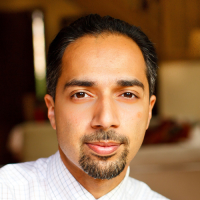
Thursday, on the 31st anniversary of Iran’s Islamic revolution, Ayatollah Khamenei’s government was fighting for its survival, as leaders of the country’s opposition Green Movement sought to take back a revolution gone astray.
Even as demonstrators participated in carefully choreographed pro-government displays, the fact that the Iranian authorities had to turn off the Internet, disable access to Gmail, and fill the streets with riot police and paramilitary Basij served to illustrate the dilemma in which the Khamenei regime now finds itself.
By coercing the Iranian people to acquiesce to the absolute rule of an unelected guardian, the government is accomplishing a revolution in a literal sense, by creating a circular movement that ends where it started.
The Iranian system has reached a point of repression saturation. It is difficult to see what more can be done in the name of religion and revolution to delay or renege on a century-long Iranian promise of justice, equality, and popular sovereignty.
In this context, February 11 takes on huge symbolic significance as the most important secular anniversary in the current Iranian political calendar. It marks the promise of a life without monarchical despotism, but also, in hindsight, all that can go wrong with a revolution.
• What’s Happening in Iran: Photos, Video, Dispatches Today, the Iranian revolution, like all its historical predecessors, is devouring its own children. The eradication of co-revolutionaries in the immediate aftermath of victory against the shah can be explained (though not excused) by the political rivalry that always follows the defeat of a common enemy. But the attempt in the last eight months to subdue the reformist wing of the political elite in Tehran constitutes an attempt to bury, once and for all, the ideals that originally animated the revolution.
What’s at stake now is not just the survival of the reformists, but the very possibility of Iran’s eventual transition toward a democratic system. By reneging on its promise of justice and political liberties—and by refusing to take part in a national debate about what the ideals and goal of the republic should be—the radical conservatives have in effect negated the very notion of a republic, and of a nation of citizens with minds of their own and the political autonomy to express themselves.
To get away with this backward march of folly, the hardliners seem to believe that they must kill the very children of the revolution—the ones who led the revolution and still feel obliged to honor its promises.
By coercing the Iranian people to acquiesce to the absolute rule of an unelected guardian, the government is accomplishing a revolution in a literal sense, by creating a circular movement that ends where it started. In order to maintain their grip on power, acting in the name of religion, the radical conservatives in government are imprisoning the very leaders who helped bring an end to secular monarchical despotism 31 years ago.
In the flawed-yet-lively Iranian electoral system, the reformists have not only been drawing on their own experience, but have also tapped into the aspirations and frustrations of several generations of Iranians. The Green Movement has resiliently, and overwhelmingly peacefully, resisted the repression with which their demands for greater transparency, justice, and accountability have been met. The movement is an amorphous amalgamation of citizens from all walks of life, including leading members of the clergy, the supposed core of the regime’s leadership.
The tent of the Green Movement is large, containing many different political philosophies and goals. There are the elements around Mir Hossein Mousavi, the opposition leader, who wants to reclaim the revolution through a nonviolent campaign within the framework of the current constitution. There are also people within the movement who see an opportunity to do away with Iran's Islamic system as a whole.
The coalition is held together not just by a rejection of the dubious election of Mahmoud Ahmadinejad, but by the realization that Iran would take a giant leap toward becoming a military dictatorship if the hardliners win.
A Green victory will not automatically lead to democracy, but it will keep the path open to a gradual, controllable transition toward democracy. A path that can keep the hope of a century-long promise alive.
Rouzbeh Parsi is research fellow at the European Institute for Security Studies
Trita Parsi is the president of the National Iranian American Council and the 2010 recipient of the Grawemeyer Award for Ideas Improving World Order.






